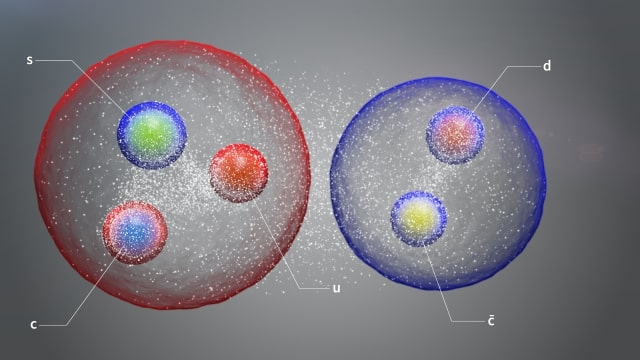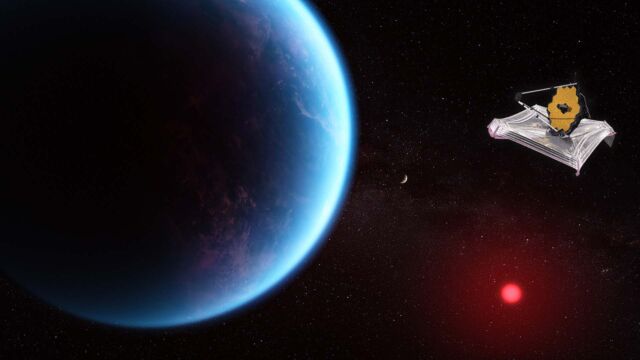On 5th July 2022, CERN announced the discovery of three new exotic particles, one of which is a pentaquark while the other two are tetraquarks.
A pentaquark is a particle made up of 5 quarks, whereas a tetraquark is made up of 4 quarks (as their respective names suggest).
The International LHCb Collaboration has observed these three particles (two of which are tetraquarks), which were never seen before at the Large Hadron Collider at CERN.
With this discovery, physicists hope to better understand how quarks bind with each other to form various particles underlying the bedrock of particle physics.
What are Quarks?
Quarks are fundamental particles that belong to the category of fermions in the Standard Model of Physics.
Quarks bind with each other, through the strong force carried by gluons, to make different kinds of subatomic particles.
The binding of quarks results in the formation of particles known as hadrons.
What are Exotic particles?
Usually, quarks bind together to form two types of hadrons – mesons and baryons.
Mesons are formed by the interaction between a quark and an anti-quark, whereas baryons (such as protons and neutrons) are made up of three quarks, and are also relatively heavy.
Apart from these, any other types of hadrons are called exotic hadrons, because they rarely exist.
Exotic hadrons include hadrons made up of more than three quarks.
For instance, tetraquarks are made up of four quarks and pentaquarks are made up of five quarks.
Exotic hadrons were theorized about 50 years ago i.e. the same time as the discovery of baryons and mesons.
However, they were not discovered until 2014, when physicists discovered tetraquarks for the first time.
In 2015, a pentaquark was also discovered at the LHC. Since then, many exotic hadrons have been discovered.
What are the New Particles Discovered at CERN?
You might ask that if we had already discovered exotic particles, what’s so special about the three particles discovered on 5th July?
Well, on 5th July 2022, the collider recorded proton-proton collision energy at 13.6 Tev (short for teraelectron volts – a unit of energy).
No collision had ever been recorded at such high energy.
Most of the tetraquarks and pentaquarks discovered usually contained charm quarks and charm antiquarks.
For pentaquarks, the rest of the quarks usually were up quarks, down quarks, and their antiquark counterparts.
Earlier discovered tetraquarks also comprised strange quarks and strange antiquarks, but no pentaquark was found having a strange quark, until now.
For the first time, physicists have discovered a pentaquark composed of a strange quark.
The pentaquark happens to have formed due to loosely bound baryon and meson.
It was also the first time that tetraquarks were found to exist in pairs. One tetraquark had a double positive charge while the other was neutral.
It is also the first time that a doubly-charged tetraquark has been discovered.
Discovery of Pentaquark Comprising a Strange Quark
The newly discovered pentaquark goes by the name PΛψs(4338)0 (yes, try reading that).
It consists of strange, up-and-down quarks along with a charm quark and charm antiquark pair.
It is also denoted as cc̄uds, where every letter denotes the respective quarks by their initials.

In the above image shown, the colors of quarks are not randomly chosen but instead, reveal information about them.
Every quark is represented with two colors, one on the boundary and the other inwards.
The inward color shows the color charge (blue, green, and red) of the quark, while the outer color denotes the charge on each (blue being negative and red being positive).
The color charge does not tell us about the actual color of the quarks, but the interaction between them.
As an electric charge describes how a particle will behave under electromagnetic force, the color charge describes the behavior of a particle under strong force.
Discovery of Pair of Tetraquarks
For the first time, physicists discovered a doubly charged tetraquark alongside its neutral brother.


The newly found pair of tetraquarks were named Tacs0(2900)++ and Tacs0(2900)0.
The doubly charged tetraquark consists of charm and up quarks along with a strange quark and down antiquark.
Its neutral companion consists of down and charm quarks along with a strange quark and up antiquark.
In the above images, we can see that the first tetraquark consists of all positively charged quarks.
Inside his neutral sibling, there lie two positively charged quarks and two negatively charged quarks, thus owing to its overall neutrality.
Future of Particle Physics at the Large Hadron Collider
The LHC runs some of the most advanced experiments in particle physics. It has already discovered 66 hadrons to date.
To continue this journey of exciting discoveries, LHC underwent some hardware updates, while it was shut down for years.
The LHCb was shut down at the end of the year 2018 to upgrade all of its detectors and hardware.
Three years later, it was restarted on 5th July 2022, after improvements were made to allow the collider to record proton-proton collisions at an energy of 13.6 Tev, which is absolutely gigantic.
Fact: In a typical nuclear fission reaction at nuclear power plants, one uranium atom releases about 200 MeV (mega electron volts) of energy.
This means that the energy, with which the protons collided during the latest run, is 68000 times the energy that a uranium atom releases while breaking apart.
With its enhanced arsenal comprising improved electronic systems and software, LHCb is expected to pick up more interesting events in the future.
New detectors will be able to detect new interactions of subatomic particles, which will help physicists to understand the fascinating world of particles better than ever.
References & External links
- https://lhcb-outreach.web.cern.ch/2022/07/05/observation-of-a-strange-pentaquark-a-doubly-charged-tetraquark-and-its-neutral-partner/
- https://home.cern/news/news/physics/lhcb-discovers-three-new-exotic-particles
- https://cds.cern.ch/record/2814136
- https://en.wikipedia.org/wiki/LHCb_experiment#LHCb_upgrade_(2019%E2%80%932021)
- History of Particle Physics & the Standard Model of Physics
- What are Quarks? Why are they so Peculiar?





